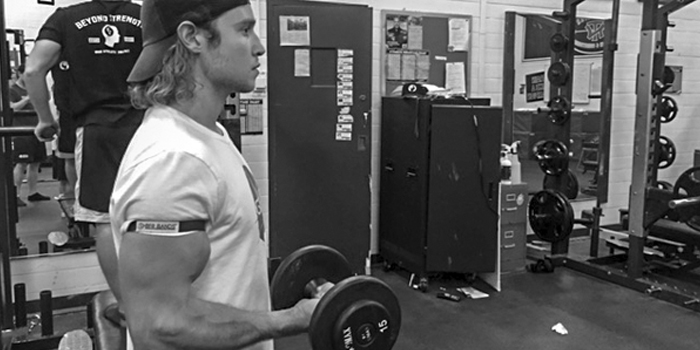
Note: Thanks to Jim Davis, staff and student wellness coordinator at New Trier High School, for his edits, his guidance, and the opportunity to conduct this research as part of my 2018 strength and conditioning internship.
The first time I tried blood flow restriction (BFR), I thought my veins were about to explode. I am a strength and conditioning intern at New Trier High School. Health and fitness are my true passion. Naturally, when I heard about this new technology, I had to investigate. Extensive scientific research supports this new training technique. Whether its blood pooling, metabolite build-up, or type 2 fiber recruitment, implementing BFR seems to have a positive effect on muscular strength.
NEW: 5 Great Exercises for the Most Hated Machine in the Gym
Johnny Owens, a physical therapist at the Brooke Army Medical Center, invented BFR to improve the muscular strength of wounded soldiers. BFR served as a safe alternative to traditional rehabilitation. It was Dr. Jeremy Leonneke, an assistant professor at the University of Mississippi, who popularized BFR as an alternative method to heavy strength training. With this method, one wraps a pressure cuff around the top portion of a limb to restrict blood from leaving the working muscle. The cuff should be tight but not fully cutting off the circulation. A 7/10 perceived tightness is recommended. With blood flow restricted, one should lift only 30% of one’s one-rep max and stick to four sets of (30, 20, 15, 15), three days a week at the most. One should consult with a medical doctor prior to engaging in this activity. In addition, if an individual has a medical condition with his or her veins or arteries, BFR training should not be used. Although the American College of Sport Medicine recommends training at loads of 70-80% on an individual’s one-rep max to achieve muscular strength (Esco, 2013), BFR is typically performed at 20-30% of an individual’s one-rep max. As such, BFR training may provide an alternative solution for maximizing athletic performance. Because strength gains can be accomplished using lighter loads, this would limit impact and compression in the joints, lower the risk of acute catastrophic injury, and potentially create a safer environment.
Theory 1
Dr. Leonneke proposed three scientific theories on the effectiveness of BFR. In one theory, the muscle cells reach a point where they are so full of fluid that they must either burst or grow. Arteries take blood into the activated muscle, and veins take blood out of the working muscle. Bands constrict the veins and not the arteries, thus causing the blood to pool in the muscle being activated. This pooling of blood is believed to aid in muscle growth and muscle strength. Master of Science Young Sub Kwon explains how blood aids in muscular strength and hypertrophy. He stated that damaged myofibrils from resistance training activate satellite cells, which trigger numerous responses in the body to aid in muscle repair and growth. The main role of blood is to transport oxygen and nutrients; without its transportation, none of these responses would be able to occur (Kwon).
Theory 2
Another theory suggests that the restriction caused by BFR builds up metabolites, such as human growth hormone (HGH), which have been shown to directly stimulate muscle growth (Kwon). During normal muscle activation, the body naturally releases metabolites to aid in muscle growth; however, these hormones do not stay long inside the muscle due to the blood flow washing them out. The opposite effect happens with BFR. During BFR training, the constricted veins prevent blood from leaving the activated muscle. This environment also increases naturally occurring HGH, which stimulates muscle growth (Kwon). This allows the metabolites to remain in this muscle tissue and aid in muscular recovery.
Theory 3
The final theory addresses the direct fatigue of the type 1 muscle fibers. During the restriction of the veins, deoxygenated blood cannot leave the muscle. Thus, it builds up and creates an anaerobic environment. The anaerobic environment pre-fatigues the type 1 muscle fibers, which require oxygen to function, so the body recruits larger, fast-twitch, type 2 muscle fibers. Type 2 muscle fibers have the greatest effect on muscular strength and hypertrophy gains over any other type of muscle fiber (Penny, 2015).
WATCH: The 6-30-30 Overload Method
These three theories receive support from studies showing increases in muscular strength after BFR training. A 2014 study conducted by Christian Cook from Bangor University examined the effects of moderate load exercise with and without BFR. The population sample used in this study included 20 male semi-professional rugby athletes. Their ages ranged from 20 to 23, and they had years of experience with resistance training. The athletes were divided into two groups with similar body masses and athletic performance. This study protocol consisted of an eight-week resistance training block. All of the athletes had set dietary plans to control their nutrition. They also had sleep logs to encourage all of the athletes to get a minimum of eight hours of sleep. All of the athletes had to participate in two consecutive days of testing to measure initial baselines for strength, power, and speed. Testing consisted of a one-rep max back squat and bench. The athletes’ vertical jumps were also tested using a force plate, and a 40-yard sprint test was conducted as well. The athletes were randomly assigned to one of the two training groups. This specific protocol was a crossover design-based experiment. The only difference between the training groups was that one group used BFR and the other group did not. The training block was three weeks long and included three resistance training sessions per week. The resistance training sessions consisted of three exercises (back squat, weighted pull-up, and bench press). The training intensity for each exercise was completed at 70% of the individual’s one-rep max. The protocol consisted of five sets of five repetitions with appropriate rest between each set for a given exercise. When comparing the two training interventions, the occlusion group resulted in significantly greater improvements in the bench press, squat, maximal sprint time, vertical jump, and 40-yard sprint. Testosterone levels were also measured and showed much higher levels in the occlusion group compared with the control group after a training session. This study indicated that lower-limb BFR training with a 70% load produced significant muscular strength and higher testosterone levels compared with non-occluded training (Cook,2014).
A 2014 meta-analysis by Dr. Jeremy Leonneke examined training variables that resulted in the greatest strength and hypertrophy outcomes with lower-body BFR training. For the studies to be included, they needed to be randomized controlled trials. Every study had to compare resistance training alone with low-intensity exercise with some form of BFR. The subject population also needed to have similar baseline characteristics. All of the studies used magnetic resonance imaging and ultrasound to report changes in muscle hypertrophy. Eleven studies met the inclusion criteria. The meta-analysis suggested that 30-40% load BFR training yielded greater significant changes in muscular strength and hypertrophy compared with previous meta-analysis using higher loads (70-80%). In addition, muscular strength and hypertrophy changes yielded a significant difference in the training frequency groups that trained only 2-3 days per week as opposed to 4-5 days per week. This means that recovery is vital to BFR training (Loenneke, 2012).
Practical BFR training application from John Meadows (mountaindog1)
BFR training has become increasingly popular. The scientific literature supports the three scientific theories behind BFR—muscle swelling, metabolite build-up, and type 2 muscle recruitment. The additional studies listed above give reason to be optimistic about BFR training. I have personally used this training technique—three times a week for one month—and noticed that my arms grew and became more vascular. I am open to incorporating this technique for the future athletes I train.
References
- Penney, S., Comana, F., Lecovin, G., Miller, K., Gonzalez, J., Stull, K., . . . National Academy of Sports Medicine. (2018, March 23). Fast-Twitch, Slow-Twitch: What's the difference and does it matter? http://blog.nasm.org/fitness/fast-twitch-slow-twitch-whats-difference-matter
- Esco, M. R. (2013, February 5). ACSM Information on Resistance Training For Health and Fitness. Retrieved April Thursday, 2018, from https://www.acsm.org/docs/brochures/resistance-training.pdf
- Cook, C. J., Kilduff, L. P., & Beaven, C. M. (2014). Improving strength and power in trained athletes with 3 weeks of occlusion training. International journal of sports physiology and performance, 9(1), 166-172. Retrieved April 23, 2018, from file:///C:/Users/Big%20Popa/Downloads/25_CookIJSPP_OcclusionTraining.pdf
- Kwon, Y. S., M.S, & Kravitz, L., Ph.D. (n.d.). How do muscles grow? Retrieved April 23, 2018, from https://www.unm.edu/~lkravitz/Articlefolder/musclesgrowLK.html.
- Loenneke, J. P., Wilson, J. M., Marín, P. J., Zourdos, M. C., & Bemben, M. G. (2012). Low intensity blood flow restriction training: a meta-analysis. European journal of applied physiology, 112(5), 1849-1859.
Nick Popa is currently interning for Jim Davis at New Trier High School in the strength and conditioning department. He graduated from Loras College with a bachelor's degree in kinesiology.









